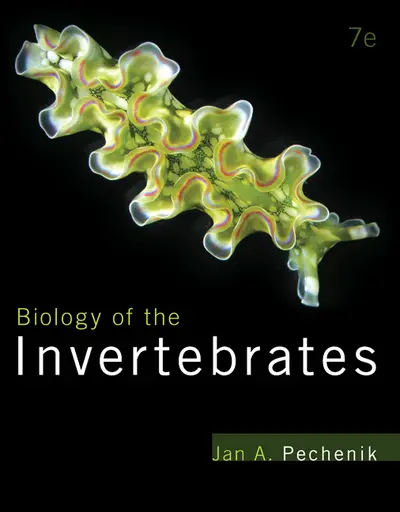My Account Details

ISBN10: 0073524182 | ISBN13: 9780073524184

* The estimated amount of time this product will be on the market is based on a number of factors, including faculty input to instructional design and the prior revision cycle and updates to academic research-which typically results in a revision cycle ranging from every two to four years for this product. Pricing subject to change at any time.
Instructor Information
Quick Actions (Only for Validated Instructor Accounts):
This textbook is the most concise and readable invertebrates book in terms of detail and pedagogy (other texts do not offer boxed readings, a second color, end of chapter questions, or pronunciation guides). All phyla of invertebrates are covered (comprehensive) with an emphasis on unifying characteristics of each group.
1 Introduction and Environmental Considerations 2 Invertebrate Classification and Relationships 3 The Protists 4 The Poriferans and Placozoans 5 Introduction to the Hydrostatic Skeleton 6 The Cnidarians 7 The Ctenophores 8 The Platyhelminthes 9 The Mesozoand: Possible Flatworm Relatives10 The Gnathifera: Rotifers, Acanthocephalans, and Two Smaller Groups11 The Nemertines 12 The Molluscs 13 The Annelids 14 The Arthropods 15 Two Phyla of Likely Arthropod Relatives: Tardigrades and Onychophorans 16 The Nematodes 17 Four Phyla of Likely Nematode Relatives: Nematomorpha, Priapulida, Kinorhyncha, and Loricifera 18 Three Phyla of Uncertain Affiliation: Gastrotricha, Chaetognatha, and Cyliophora 19 The Lophophorates (Phoronids, Brachiopods, Bryozoans) and Entoprocts 20 The Echinoderms 21 The Hemichordates 22 The Xenoturbellids: Deuterostomes at Last? 23 The Nonvertebrate Chordates 24 Invertebrate Reproduction and Development--An Overview
3 The Protists 4 The Poriferans and Placozoans 5 Introduction to the Hydrostatic Skeleton 6 The Cnidarians 7 The Ctenophores 8 The Platyhelminthes 9 The Mesozoand: Possible Flatworm Relatives10 The Gnathifera: Rotifers, Acanthocephalans, and Two Smaller Groups11 The Nemertines 12 The Molluscs 13 The Annelids 14 The Arthropods 15 Two Phyla of Likely Arthropod Relatives: Tardigrades and Onychophorans 16 The Nematodes 17 Four Phyla of Likely Nematode Relatives: Nematomorpha, Priapulida, Kinorhyncha, and Loricifera 18 Three Phyla of Uncertain Affiliation: Gastrotricha, Chaetognatha, and Cyliophora 19 The Lophophorates (Phoronids, Brachiopods, Bryozoans) and Entoprocts 20 The Echinoderms 21 The Hemichordates 22 The Xenoturbellids: Deuterostomes at Last? 23 The Nonvertebrate Chordates 24 Invertebrate Reproduction and Development--An Overview
5 Introduction to the Hydrostatic Skeleton 6 The Cnidarians 7 The Ctenophores 8 The Platyhelminthes 9 The Mesozoand: Possible Flatworm Relatives10 The Gnathifera: Rotifers, Acanthocephalans, and Two Smaller Groups11 The Nemertines 12 The Molluscs 13 The Annelids 14 The Arthropods 15 Two Phyla of Likely Arthropod Relatives: Tardigrades and Onychophorans 16 The Nematodes 17 Four Phyla of Likely Nematode Relatives: Nematomorpha, Priapulida, Kinorhyncha, and Loricifera 18 Three Phyla of Uncertain Affiliation: Gastrotricha, Chaetognatha, and Cyliophora 19 The Lophophorates (Phoronids, Brachiopods, Bryozoans) and Entoprocts 20 The Echinoderms 21 The Hemichordates 22 The Xenoturbellids: Deuterostomes at Last? 23 The Nonvertebrate Chordates 24 Invertebrate Reproduction and Development--An Overview
7 The Ctenophores 8 The Platyhelminthes 9 The Mesozoand: Possible Flatworm Relatives10 The Gnathifera: Rotifers, Acanthocephalans, and Two Smaller Groups11 The Nemertines 12 The Molluscs 13 The Annelids 14 The Arthropods 15 Two Phyla of Likely Arthropod Relatives: Tardigrades and Onychophorans 16 The Nematodes 17 Four Phyla of Likely Nematode Relatives: Nematomorpha, Priapulida, Kinorhyncha, and Loricifera 18 Three Phyla of Uncertain Affiliation: Gastrotricha, Chaetognatha, and Cyliophora 19 The Lophophorates (Phoronids, Brachiopods, Bryozoans) and Entoprocts 20 The Echinoderms 21 The Hemichordates 22 The Xenoturbellids: Deuterostomes at Last? 23 The Nonvertebrate Chordates 24 Invertebrate Reproduction and Development--An Overview
9 The Mesozoand: Possible Flatworm Relatives10 The Gnathifera: Rotifers, Acanthocephalans, and Two Smaller Groups11 The Nemertines 12 The Molluscs 13 The Annelids 14 The Arthropods 15 Two Phyla of Likely Arthropod Relatives: Tardigrades and Onychophorans 16 The Nematodes 17 Four Phyla of Likely Nematode Relatives: Nematomorpha, Priapulida, Kinorhyncha, and Loricifera 18 Three Phyla of Uncertain Affiliation: Gastrotricha, Chaetognatha, and Cyliophora 19 The Lophophorates (Phoronids, Brachiopods, Bryozoans) and Entoprocts 20 The Echinoderms 21 The Hemichordates 22 The Xenoturbellids: Deuterostomes at Last? 23 The Nonvertebrate Chordates 24 Invertebrate Reproduction and Development--An Overview
11 The Nemertines 12 The Molluscs 13 The Annelids 14 The Arthropods 15 Two Phyla of Likely Arthropod Relatives: Tardigrades and Onychophorans 16 The Nematodes 17 Four Phyla of Likely Nematode Relatives: Nematomorpha, Priapulida, Kinorhyncha, and Loricifera 18 Three Phyla of Uncertain Affiliation: Gastrotricha, Chaetognatha, and Cyliophora 19 The Lophophorates (Phoronids, Brachiopods, Bryozoans) and Entoprocts 20 The Echinoderms 21 The Hemichordates 22 The Xenoturbellids: Deuterostomes at Last? 23 The Nonvertebrate Chordates 24 Invertebrate Reproduction and Development--An Overview
13 The Annelids 14 The Arthropods 15 Two Phyla of Likely Arthropod Relatives: Tardigrades and Onychophorans 16 The Nematodes 17 Four Phyla of Likely Nematode Relatives: Nematomorpha, Priapulida, Kinorhyncha, and Loricifera 18 Three Phyla of Uncertain Affiliation: Gastrotricha, Chaetognatha, and Cyliophora 19 The Lophophorates (Phoronids, Brachiopods, Bryozoans) and Entoprocts 20 The Echinoderms 21 The Hemichordates 22 The Xenoturbellids: Deuterostomes at Last? 23 The Nonvertebrate Chordates 24 Invertebrate Reproduction and Development--An Overview
15 Two Phyla of Likely Arthropod Relatives: Tardigrades and Onychophorans 16 The Nematodes 17 Four Phyla of Likely Nematode Relatives: Nematomorpha, Priapulida, Kinorhyncha, and Loricifera 18 Three Phyla of Uncertain Affiliation: Gastrotricha, Chaetognatha, and Cyliophora 19 The Lophophorates (Phoronids, Brachiopods, Bryozoans) and Entoprocts 20 The Echinoderms 21 The Hemichordates 22 The Xenoturbellids: Deuterostomes at Last? 23 The Nonvertebrate Chordates 24 Invertebrate Reproduction and Development--An Overview
17 Four Phyla of Likely Nematode Relatives: Nematomorpha, Priapulida, Kinorhyncha, and Loricifera 18 Three Phyla of Uncertain Affiliation: Gastrotricha, Chaetognatha, and Cyliophora 19 The Lophophorates (Phoronids, Brachiopods, Bryozoans) and Entoprocts 20 The Echinoderms 21 The Hemichordates 22 The Xenoturbellids: Deuterostomes at Last? 23 The Nonvertebrate Chordates 24 Invertebrate Reproduction and Development--An Overview
19 The Lophophorates (Phoronids, Brachiopods, Bryozoans) and Entoprocts 20 The Echinoderms 21 The Hemichordates 22 The Xenoturbellids: Deuterostomes at Last? 23 The Nonvertebrate Chordates 24 Invertebrate Reproduction and Development--An Overview
21 The Hemichordates 22 The Xenoturbellids: Deuterostomes at Last? 23 The Nonvertebrate Chordates 24 Invertebrate Reproduction and Development--An Overview
23 The Nonvertebrate Chordates 24 Invertebrate Reproduction and Development--An Overview
Need support? We're here to help - Get real-world support and resources every step of the way.